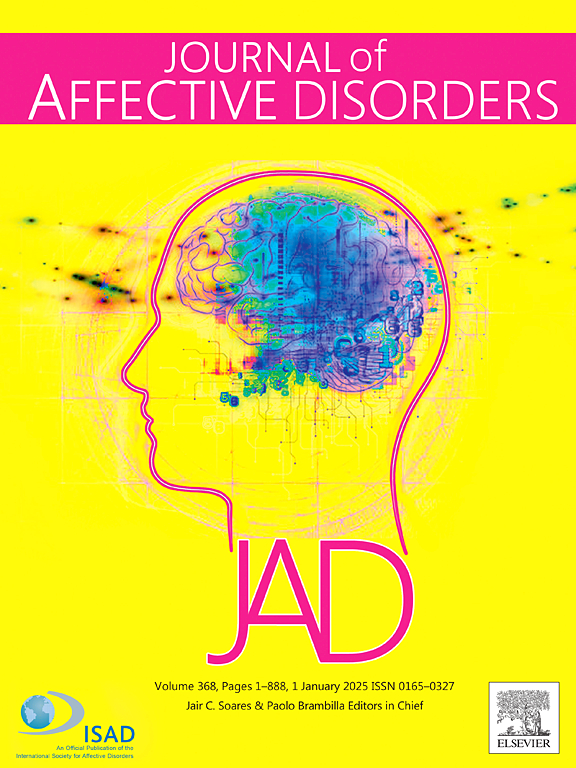The mediating role of CRP in the relationship between physical activity and depression: A nonlinear analysis
IF 4.9
2区 医学
Q1 CLINICAL NEUROLOGY
引用次数: 0
Abstract
Background
Physical activity can alleviate depressive symptoms and has anti-inflammatory effects. However, the extent to which inflammation mediates this relationship is unclear. This study explores the non-linear relationship between the metabolic equivalent of recreational physical activity (MET-RPA), high-sensitivity C-reactive protein (hs-CRP), and depressive symptoms, assessing hs-CRP's mediating role.
Methods
Data from the National Health and Nutrition Examination Survey from 2013 to 2020 were used, including the Patient Health Questionnaire-9 (PHQ-9) scores, hs-CRP, and PA data. Restricted cubic spline models analyzed non-linear relationships, and mediation analysis assessed the mediating role of hs-CRP.
Results
MET-RPA exhibited a non-linear “U” shaped relationship with depressive symptoms, where increased MET-RPA initially reduced depressive symptoms risk until a lowest point (3072.96 MET-min/week; i.e., 375 min of vigorous exercise or 750 min of moderate-intensity exercise per week), beyond which the risk increased. A non-linear “L” shaped relationship was observed between MET-RPA and CRP, with a lowest point of 3888.24 MET-min/week. Furthermore, a significant inflexion point was identified at a CRP level of 9.85 mg/L, where depressive symptoms risk increased with rising CRP levels but at a slower rate beyond this point. Mediation analysis revealed that CRP significantly mediated the relationship between MET-RPA and depressive symptoms, accounting for 8.14 % of the total effect.
Conclusion
Moderate levels of RPA significantly reduce depressive symptoms, while excessive RPA slightly increases the risk of depression. The anti-inflammatory effect of exercise, represented by decreased hs-CRP levels, plays a partial but significant mediating role in the relationship between RPA and depression.
CRP在运动与抑郁关系中的中介作用:一个非线性分析。
背景:体育活动可以缓解抑郁症状,并具有抗炎作用。然而,炎症介导这种关系的程度尚不清楚。本研究探讨休闲体育活动代谢当量(MET-RPA)、高敏c反应蛋白(hs-CRP)与抑郁症状之间的非线性关系,评估hs-CRP的中介作用。方法:采用2013 - 2020年全国健康与营养检查调查数据,包括患者健康问卷-9 (PHQ-9)评分、hs-CRP和PA数据。限制三次样条模型分析非线性关系,中介分析评估hs-CRP的中介作用。结果:MET-RPA与抑郁症状呈非线性“U”型关系,MET-RPA增加最初会降低抑郁症状的风险,直到最低点(3072.96 MET-min/week;即375 分钟的剧烈运动或750 分钟的中等强度运动),超过这个数值,风险就会增加。MET-RPA与CRP呈非线性“L”型关系,最低点为3888.24 MET-min/week。此外,在CRP水平为9.85 mg/L时,发现了一个显著的拐点,在这个拐点上,抑郁症状的风险随着CRP水平的升高而增加,但超过这个拐点后的速度较慢。中介分析显示,CRP显著介导MET-RPA与抑郁症状的关系,占总效应的8.14% %。结论:中等水平的RPA可显著减轻抑郁症状,而过量的RPA可轻微增加抑郁风险。运动的抗炎作用,以降低hs-CRP水平为代表,在RPA与抑郁之间的关系中起部分但显著的中介作用。
本文章由计算机程序翻译,如有差异,请以英文原文为准。
求助全文
约1分钟内获得全文
求助全文
来源期刊

Journal of affective disorders
医学-精神病学
CiteScore
10.90
自引率
6.10%
发文量
1319
审稿时长
9.3 weeks
期刊介绍:
The Journal of Affective Disorders publishes papers concerned with affective disorders in the widest sense: depression, mania, mood spectrum, emotions and personality, anxiety and stress. It is interdisciplinary and aims to bring together different approaches for a diverse readership. Top quality papers will be accepted dealing with any aspect of affective disorders, including neuroimaging, cognitive neurosciences, genetics, molecular biology, experimental and clinical neurosciences, pharmacology, neuroimmunoendocrinology, intervention and treatment trials.
 求助内容:
求助内容: 应助结果提醒方式:
应助结果提醒方式:


